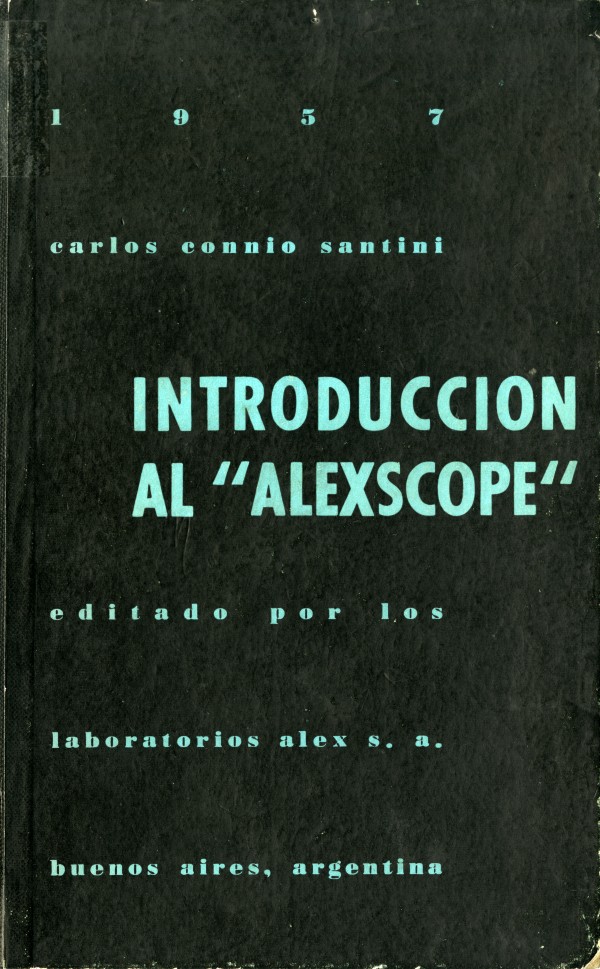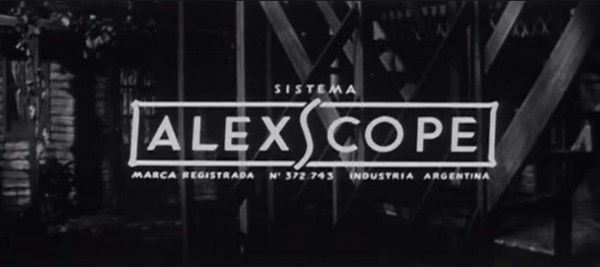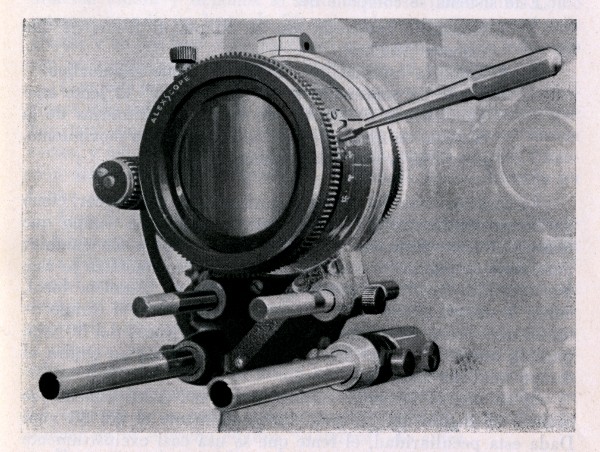An Argentine anamorphic widescreen system used both for production and exhibition of local cinema in the late 1950s.
Film Explorer

Identification
23.16mm x 18.30mm (0.912 in x 0.720 in).
2.55:1 (with magnetic sound), or 2.35:1 (with optical, or Perspecta, sound).
Color or B/W.
1
AlexScope prints were released in either B/W or Color. Among the color processes used were Agfacolor and Ferraniacolor.
Sistema AlexScope
The format was originally designed to use Perspecta directional monaural optical soundtracks, however it is possible 4-track magnetic stripe sound may have been used on later prints.
23.80mm x 18.67mm (0.937 in x 0.735 in).
Color or B/W.
History
The 1950s witnessed the global emergence of widescreen systems as the new model for film spectacle. Led by CinemaScope, this novelty grew worldwide at an accelerating rate, reinvigorating industrial cinema in its fight against the birth and ascension of television. As had happened with sound, the early years of development saw the emergence of differing local models in many countries. This was the case in Argentina, where CinemaScope and VistaVision had to fight different battles with the government to establish themselves. Under Juan Domingo Perón’s government, Argentina’s relations with the US state, and American corporations, were extremely tense. At the same time, the Argentine government had frozen the price of movie tickets – local exhibitors who wanted to adapt their theaters to these new, imported proprietary systems were fighting an uphill battle to maintain profitability.
Meanwhile, following the trend for “import substitution” in postwar Argentina, several vernacular ventures emerged – among these, the only one that achieved significant inroads was AlexScope. AlexScope debuted at a moment when the Argentine cinema industry was going through one of its toughest periods. Amidst political turmoil and economic crises, several film studios, including Lumitón, EFA and Emelco, had closed or gone bankrupt – domestic film production plummeted from 43 movies released in 1955 to only 16 in 1957.
However, bucking the trend was Laboratorios Alex, founded in 1929 by the Italian Alex Connio, which managed to maintain its position as one of the most dynamic Argentine film industry players during this period (Kohen, 2000). The company had already been a pioneer in the local development of color film, with the creation of the AlexColor system in the early 1940s. Eventually, after a series of unsuccessful attempts, it was at Laboratorios Alex that the first local color feature film, Lo que le pasó a Reynoso (1955), was developed. Once the color obstacle had been overcome, Carlos Connio Santini (Alex’s son) began to experiment with widescreen anamorphic systems. This eventually culminated in the development of AlexScope, Argentina’s version of CinemaScope.
This new creation was first presented in 1957, accompanied by a manual for both exhibitors and filmmakers entitled Introducción al “Alexscope” (Introduction to “Alexscope”). The booklet stated that “Alex Laboratories could not remain unresponsive to this new technical development and, after patient studies and research, they have made available to the Producers, Studios and Technicians of the country their newest and most recent service: the ‘ALEXSCOPE’” (Connio Santini, 1957: p. 9). The manual gave a detailed account of the steps that had led to this result and the full characteristics of the final product. In this sense, the manual did not seek to raise up AlexScope from a nationalistic point of view, but rather to position Alexscope within the context of the proliferating range of competing, international widescreen systems. Presumably, the hope was that exhibitors who had already made the technical renovations required for CinemaScope could also incorporate this locally developed technology, thus allowing for the screening of Argentine movies filmed in AlexScope.
The system debuted on May 4, 1957, with the premiere of Todo sea para bien, an adaptation of a play by Luigi Pirandello. Although its premiere went generally unnoticed by audiences and critics alike, the film’s release nevertheless marked the start of the assimilation of widescreen technology by the Argentinian film industry. Released a few months later, on October 10, Fantoche was the first film to combine AlexScope with Agfacolor and Perspecta sound, signaling the industry’s intent to achieve ever-greater heights of cinematic spectacle. In the following years, at least nine films were made in AlexScope, ranging from social melodramas set in Argentina’s inland, such as Zafra (1959), to children’s movies, like Mientras haya un circo (1958). The films are notable for their use of sweeping, panoramic views of Argentina’s heartland and colorful musical numbers, elements which emphasized the visual splendor that could be achieved with the new system.
Perhaps the most widely known movie shot in AlexScope is Rosaura a las diez (Rosa at 10 O'Clock) (1958), an adaptation of a renowned 1955 Argentine novel by Marco Denevi, which many critics and historians now regard as a milestone in the evolution of modern Argentinian cinema. Here, widescreen was employed as a sophisticated, stylistic device to present the psychological intricacies of the plot, rather than in the more habitual service of the spectacular.
At present, it is not known exactly which was the last film shot in AlexScope, or when the system completely ceased to be used. By the early 1960s, however, it is apparent that it was already in disuse, and Argentine films shot in widescreen after this point give no specific credits as to the systems used. In January 1969, a fire at Laboratorios Alex resulted in the loss of the majority of the master negatives of the films processed and archived there – including many AlexScope productions. However, two recent restorations of Rosaura a las diez – the first in 2001, overseen by Juan José Stagnaro for the Mar del Plata Film Festival; the second in 2024 carried out by Cubic Restoration and the Sociedad por el Patrimonio Audiovisual – stand as a fitting testimony to the system.
Selected Filmography
B/W feature film. A social historical drama shot in the rural settings of Buenos Aires province.
B/W feature film. A social historical drama shot in the rural settings of Buenos Aires province.
Feature film shot in Ferraniacolor. A family romantic comedy with scenes shot in the hills of Cordoba province.
Feature film shot in Ferraniacolor. A family romantic comedy with scenes shot in the hills of Cordoba province.
Feature film shot in Agfacolor. A social drama set in the rural settings of Jujuy province.
Feature film shot in Agfacolor. A social drama set in the rural settings of Jujuy province.
B/W feature film adapted from a play by Spanish playwright Antonio Buero Vallejo.
B/W feature film adapted from a play by Spanish playwright Antonio Buero Vallejo.
Feature film shot in Agfacolor. A comedy starring renowned film comedian Luis Sandrini. First color production released in AlexScope.
Feature film shot in Agfacolor. A comedy starring renowned film comedian Luis Sandrini. First color production released in AlexScope.
Feature film. A family drama set in a circus.
Feature film. A family drama set in a circus.
B/W feature film. A crime mystery adapted from a novel by Argentine author Marco Denevi.
B/W feature film. A crime mystery adapted from a novel by Argentine author Marco Denevi.
B/W feature film. A drama adapted from Luigi Pirandello’s play Tutto per bene. First production released in AlexScope.
B/W feature film. A drama adapted from Luigi Pirandello’s play Tutto per bene. First production released in AlexScope.
Feature film shot in Agfacolor. A social drama set in the rural settings of Jujuy province.
Feature film shot in Agfacolor. A social drama set in the rural settings of Jujuy province.
Technology
According to the contemporaneous guide to AlexScope, Introducción al “AlexScope” by Carlos Connio Santini, the system offered three possibilities:
“1. Direct filming of Cinemascope format films with AlexScope optical equipment;
2. Conversion from 'anamorphic' to 'flat' by processes exclusive to our Laboratory;
3. Filming with a regular camera and converting the images from 'flat' to 'anamorphic' by laboratory processes” (Connio Santini, 1957, p. 41).
The manual also stated that all these processes were based on the international standards for CinemaScope.
The anamorphizing and de-anamorphizing processes are not explained in great technical detail in the manual. Instead, it gives a practical account of the elements and processes necessary for the use of AlexScope with existing equipment on the market. Only Mitchell cameras could be adapted – the system could not be used with Debrie, or Arriflex, cameras. The technology consisted of support rods, which had to be fitted to the front of the camera, a special mount that supported the anamorphic lens and a set of gears that synchronized the anamorphic lens with any of the primary lenses of the camera – allowing focus to be pulled on the primary and anamorphic lenses with a single movement.
In 1957, when AlexScope was brought to the market, optical sound was the only technology available in Argentina. Therefore, MGM's Perspecta Sound was chosen to replicate the experience of stereo sound. The final sound mix was produced in the re-recording room by means of a special mixing console, fitted with a full three-channel integrator and a sound locator.
For projection, exhibitors had to carefully adjust the supplied AlexScope equipment to marry accurately with the varying size and position of projector aperture plates specific to different proprietary projection systems; the anamorphic lens assembly was then attached to the front of the regular projector lens, in a similar fashion to the method used when adapting the camera equipment.
References
Connio Santini, Carlos (1957). Introducción al “Alexscope”. Buenos Aires: Laboratorios Alex S.A.
España, Claudio (2005). “Transformaciones. Cine argentino 1957–1983: modernidad y vanguardias”. In Cine argentino: Modernidad y vanguardias, 1957/1983 (Volume 1), Claudio España, pp. 24–159. Buenos Aires: Fondo Nacional de las Artes.
Kelly-Hopfenblatt, Alejandro (2022). “1954, 14 de marzo en Mar del Plata. Argentina en relieve: la consolidación de la espectacularidad en las pantallas de cine de los años cincuenta”. In En la cartelera. Cine y culturas cinematográficas en América Latina, 1896–2020, Alejandro Kelly-Hopfenblatt & Nicolás Poppe (eds), pp. 223–60. Madrid: Iberoamericana-Vervuert.
Kohen, Héctor (2005). “Laboratorios Alex”. In Cine argentino: Modernidad y vanguardias, 1957/1983 (Volume 1), Claudio España, pp. 392–403. Buenos Aires: Fondo Nacional de las Artes.
Patents
Compare
Related entries
Author
Alejandro Kelly-Hopfenblatt holds a PhD in History and Theory of the Arts from the Universidad de Buenos Aires. He is currently a Zemurray-Stone Postdoctoral Fellow at the Stone Center for Latin American Studies at Tulane University, New Orleans, LA. His research is focused on the history of Latin American film industries, especially that of Argentina, and issues of cosmopolitanism, modernity and international commercialization. He is the author of Modernidad y teléfonos blancos: La comedia burguesa en el cine argentino de los años ’40 (Biblioteca ENERC-INCAA-Ciccus, 2019) and co-editor, with Nicolás Poppe, of En la cartelera: Cine y culturas cinematográficas en América Latina, 1896–2020 (Iberoamericana-Vervuert, 2022).
Biblioteca ENERC-INCAA; Museo del Cine (Pablo Ducrós Hicken).
Kelly-Hopfenblatt, Alejandro (2024). “AlexScope”. In James Layton (ed.), Film Atlas. www.filmatlas.com. Brussels: International Federation of Film Archives / Rochester, NY: George Eastman Museum.





